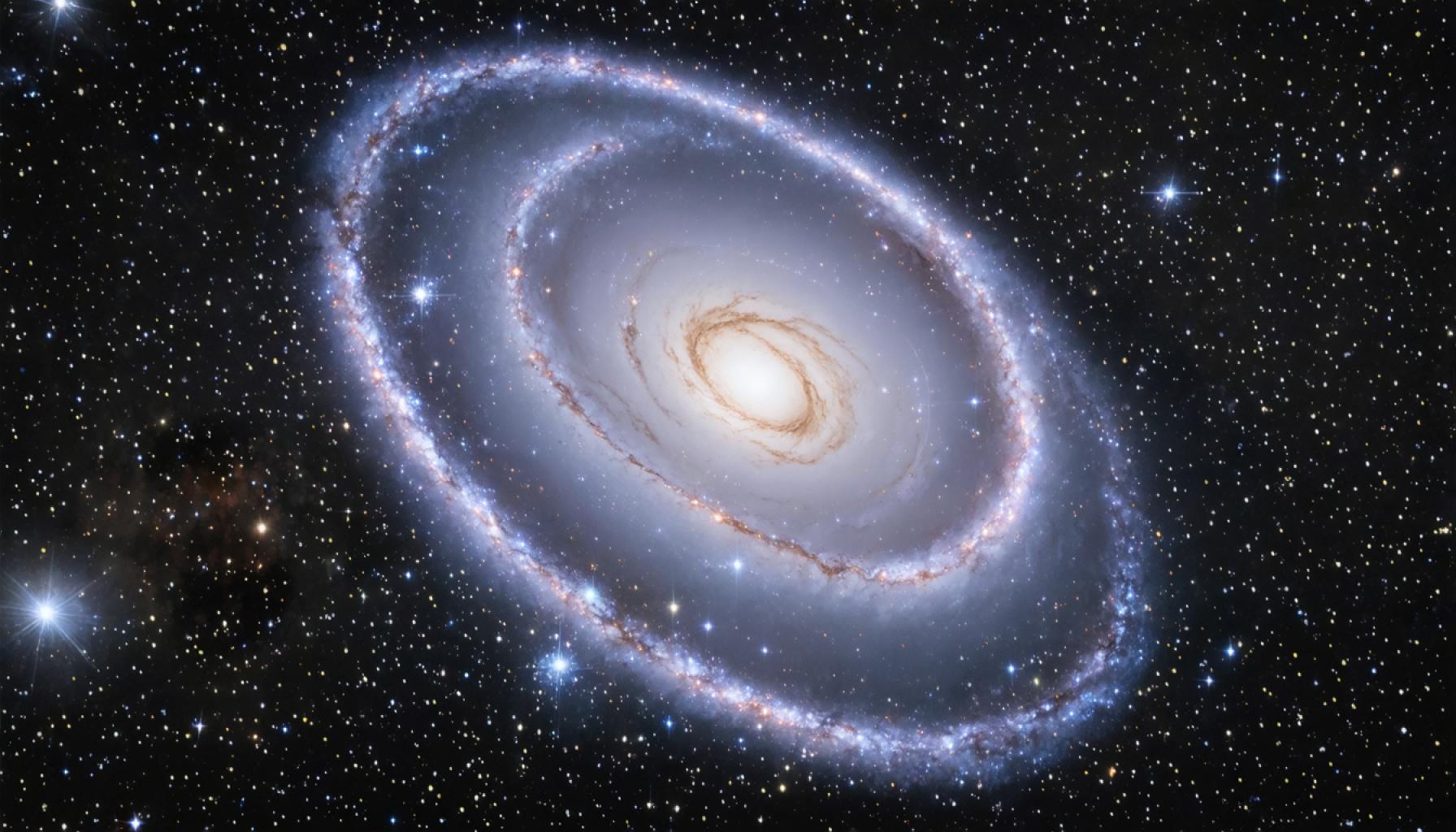
- The James Webb Space Telescope has discovered the “Big Wheel,” a massive spiral galaxy 11.7 billion light-years away, dramatically altering concepts of early galaxy formation.
- This galaxy, five times the Milky Way’s mass, challenges existing cosmological models about galaxies just two billion years post-Big Bang.
- Characterized by a red core and spanning 100,000 light-years, the Big Wheel’s grand scale and spiral arms stun scientists.
- Discovered during the study of a nearby quasar, it highlights an unexpectedly dense cosmic region where galaxy mergers abound.
- Researchers are prompted to explore these early universe phenomena further, as they offer new insights into galactic evolution.
Amidst the silent tapestry of the cosmos, the James Webb Space Telescope has unveiled a colossal revelation—a spiral galaxy dubbed the “Big Wheel,” sprawling at an astonishing 11.7 billion light-years away. This celestial titan boasts a mass five times that of our own Milky Way, defying conventional wisdom about galaxy formation in the universe’s infancy.
In the boundless stretch of the universe, “Big Wheel” emerges like an ancient leviathan, a relic suspended from the vibrant dawn of time itself. As one of the largest spiral galaxies ever detected from this era, its presence is as improbable as encountering a living dinosaur. This cosmic wonder redefines our understanding of galaxy formation just two billion years post-Big Bang—a swath of history when the universe was still a fledgling dominion of swirling gases and embryonic stars.
Upon closer examination through the lenses of the James Webb Space Telescope, the Big Wheel reveals its grand design—a red, compact core embraced by an elegant stellar disk, stretching a massive 100,000 light-years across. Spiral arms swirl in celestial choreography, an echo of the Milky Way’s graceful spires, yet their majestic width starkly challenges existing cosmological simulations.
Scientists, led by the University of Milano-Bicocca, embarked on this serendipitous discovery while studying a nearby quasar—a lighthouse of swirling superheated gases heralding a supermassive black hole. In the dense cosmic crowd surrounding this quasar, the Big Wheel made its dramatic debut, shining as an emblem of unexpected immensity amidst a throng of smaller galaxies.
Like jewels illuminated under a jeweler’s loupe, multiwavelength observations paint a picture of Big Wheel’s environment—an extravagantly populous domain where galaxy mergers are commonplace, and the cosmic density outshines the universe’s average tenfold. Such a crowded cradle perhaps catalyzed the rapid mass and size acquisition of this galactic marvel, pushing researchers to reconsider how such large disk galaxies could manifest in these early epochs.
“Exceptionally dense environments,” notes one study co-author from the University of Milano-Bicocca, “are akin to uncharted territories, untapped archives of the universe’s nascent ambitions.” These findings invite scholars to peer through fresh lenses, to map these early universe behemoths more thoroughly and piece together the sprawling puzzle of galactic origins.
The revelation of Big Wheel urges us to reconsider our cosmic narratives, offering an illustrious chapter of fortuitous discovery. May its spirals inspire and recalibrate our understanding of the universe’s genesis—a testament to the boundless possibilities that the cosmos harbor beyond our sight.
Unveiling the Mysteries of the Colossal “Big Wheel” Galaxy: A New Cosmic Perspective
Understanding the “Big Wheel” Galaxy: A Cosmic Colossus
The recent discovery of the “Big Wheel” galaxy by the James Webb Space Telescope has captured the imagination of astronomers and enthusiasts alike. Situated a staggering 11.7 billion light-years away, this galaxy defies traditional theories of galaxy formation by boasting a mass five times that of the Milky Way, during a period just 2 billion years post-Big Bang.
Key Features of the “Big Wheel” Galaxy
– Immense Size and Structure: Stretching 100,000 light-years across, the “Big Wheel” features a red, compact core surrounded by a stellar disk, with spiral arms reminiscent of the Milky Way’s, yet on a much grander scale.
– Dense Cosmic Environment: The galaxy resides in a particularly dense area of the universe, where galaxy mergers were frequent, likely contributing to its rapid growth and mass accumulation.
– Multiwavelength Observations: These observations have highlighted its rich environment, where the density surpasses the average cosmic density tenfold, offering insights into its accelerated formation.
How-to Explore Further
1. Use Online Astronomy Platforms: Engage with platforms like NASA’s HubbleSite or the European Space Agency’s website to access databases of stellar images and discoveries.
2. Attend Astronomy Talks and Seminars: Many universities and space agencies offer lectures that delve into recent astronomical discoveries.
Real-World Use Cases and Implications
The study of galaxies like the “Big Wheel” enhances our understanding of cosmic evolution and may influence the development of astrophysical models. Such findings can also contribute to our knowledge of gravitational waves, dark matter, and early universe dynamics.
Market Forecasts & Industry Trends
The discovery underscores the increasing importance of advanced telescopes and space exploration technology. As telescopes like the James Webb continue to push the boundaries, expect accelerated advancements in related industries, such as data analysis, AI for space exploration, and educational outreach programs.
Pros and Cons Overview of the Discovery
Pros:
– Advances Scientific Knowledge: Redefines our understanding of galaxy formation.
– Promotes Technological Innovation: Spurs development of more precise observational instruments.
Cons:
– Complex Data Interpretation: Requires advanced technology and expertise.
– Funding Challenges: High costs may limit similar research endeavors.
Controversies and Limitations
While the discovery reshapes existing theories, it also raises questions about the limitations of current cosmological simulations. Some astrophysicists argue that a revision of these models is necessary to accommodate such anomalous galactic structures.
Security & Sustainability
Securing continued funding and support for space exploration initiatives is crucial for sustainability. Governments and organizations must prioritize these investments to ensure continued astronomical breakthroughs.
Insights & Predictions
This discovery will likely prompt a surge in related research, including further examination of the early universe’s galaxy formation processes. Expect new models and theories to emerge, challenging existing paradigms.
Actionable Recommendations
– Stay Informed: Follow updates on space missions and join online communities devoted to space exploration.
– Support Science Education: Advocate for increased funding and programs in STEM education to inspire future astronomers.
Suggested Related Link
For more information about the latest advancements in astronomy, visit NASA or European Space Agency.
In conclusion, the “Big Wheel” serves as a beacon of discovery, inviting astronomers to venture deeper into the cosmic past, reshaping the narrative of our universe’s origins and inspiring new generations of scientific explorers.



